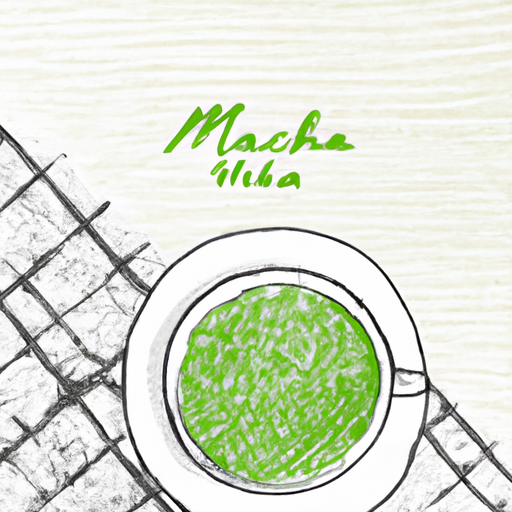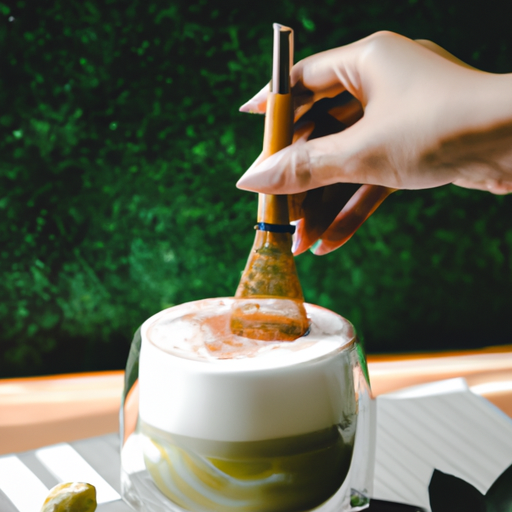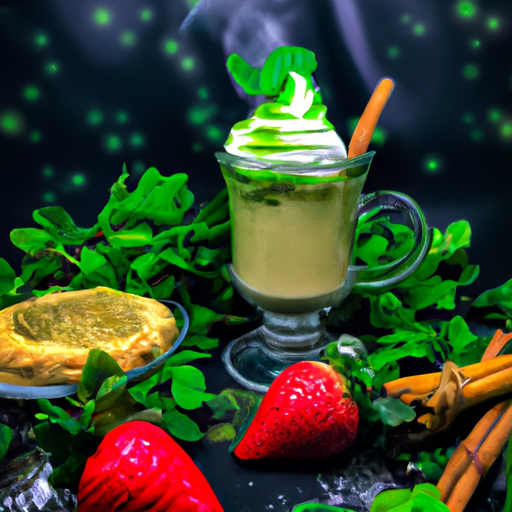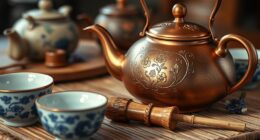When I unsealed the matcha powder pouch, an earthy and grassy scent enveloped me, immediately evoking the tranquility of a serene tea garden in Japan. This aroma was like a soft wind, hinting at the comforting promise of a relaxing tea experience.
For those who have never experienced matcha before, it might be difficult to imagine what it smells like. But, trust me, its scent is as unique and enticing as its taste.
Matcha, a finely powdered green tea, has been gaining popularity worldwide for its numerous health benefits and distinct flavor. But, what about its aroma? What does matcha smell like?
In this article, I will delve into the olfactory side of matcha and explore its scent, the factors that affect it, and how it can be described. So, sit back, brew yourself a warm cup of matcha, and let’s dive in.
Key Takeaways
- Matcha has a unique aroma and distinct flavor that is both earthy and sweet, complemented by a subtle hint of umami.
- High-quality matcha contains a complex mix of aroma compounds, which can vary from sweet and floral to earthy and vegetal.
- Proper storage can help preserve the matcha aroma and maintain the flavor and quality of the tea.
- Matcha offers aromatherapy benefits, creating a sense of calm and relaxation.
An Introduction to Matcha
You’re probably wondering what matcha, the beloved Japanese green tea, tastes and smells like. Well, let me tell you, matcha has a unique aroma that is both earthy and sweet. The scent is often described as vegetal, with hints of freshly cut grass, spinach, and seaweed. This aroma is a result of the unique production process of matcha, which involves shading the tea leaves for several weeks before they’re harvested. This forces the tea plant to produce more chlorophyll and amino acids, which gives matcha its distinct flavor and aroma.
In addition to the unique production process, matcha is also known for its ceremonial practices. In Japan, matcha is traditionally prepared and presented in a special bowl called a chawan. The matcha is whisked with a bamboo whisk called a chasen until it develops a thick, frothy consistency. The aroma of the matcha is an important part of the ceremony, with the aroma being enjoyed before the tea is even consumed.
Now that you have a better understanding of the production and ceremonial practices surrounding matcha, let’s take a look at the origins of this beloved Japanese green tea.
The Origins of Matcha
Originating in Japan, the finely ground green tea powder known as matcha has a rich history dating back to the 12th century. Matcha was first introduced to Japan by a Buddhist monk named Eisai, who brought the tea seeds from China. The tea became popular among Japanese monks and samurais due to its high caffeine content and calming effects. Eventually, matcha became an important part of Japanese culture, and it is now enjoyed around the world.
The origins of matcha are deeply intertwined with Japanese culture and tradition. Matcha has been used in Japanese tea ceremonies for centuries, which are highly ritualized events that involve the preparation and serving of matcha to guests. Tea ceremonies are a way for people to connect with each other and with nature, and they are considered a form of meditation. Matcha is also used in traditional Japanese cooking, such as in sweets and desserts.
Matcha’s cultural significance is reflected in the way it is produced. Matcha is made from shade-grown tea leaves, which are carefully harvested, steamed, and dried. The leaves are then ground into a fine powder using a stone mill. This process is labor-intensive and requires a high level of skill, which is why matcha is often more expensive than other types of tea. However, the result is a vibrant green powder that is highly prized for its flavor and health benefits.
The origins of matcha are deeply rooted in Japanese culture and tradition. The tea has been an important part of Japanese life for centuries, and it continues to be enjoyed around the world today. Matcha’s cultural significance is reflected in the way it is produced, which is a labor-intensive process that requires a high level of skill. In the next section, we will explore how matcha is produced and the different types of matcha available.
How Matcha is Produced
Get ready to learn how matcha is made, from the cultivation of the tea plants to the final grinding of the leaves into a fine powder!
Matcha farming techniques involve shading the tea plants for a few weeks before harvest. This process helps to increase the chlorophyll content in the leaves, which gives matcha its vibrant green color.
The tea plants are then hand-picked, and only the youngest and most tender leaves are used to make matcha. Once the leaves have been picked, they are steamed to stop the oxidation process and then dried.
The dried leaves, called tencha, are then sorted and de-stemmed before being ground into a fine powder using a stone mill. This final step is what gives matcha its unique texture and flavor.
The aroma of matcha is also an important aspect, and many tea producers conduct aroma analysis to ensure the quality and consistency of their product. Matcha has numerous health benefits, including high levels of antioxidants and amino acids.
These properties make matcha a popular choice for those seeking a natural energy boost or looking to improve their overall well-being. So, if you’re looking for a delicious and nutritious drink, give matcha a try!
The Health Benefits of Matcha
I absolutely love matcha, not just for its delicious taste, but also for its numerous health benefits.
One of the key benefits is that it’s high in antioxidants, which helps to protect our bodies against damage from free radicals.
Additionally, matcha is known to boost metabolism, making it a great beverage to incorporate into your weight loss regimen.
Finally, matcha also has a calming effect on the body, making it a perfect drink to help reduce stress and anxiety.
Overall, matcha is a superfood that’s definitely worth incorporating into your daily routine.
High in Antioxidants
With its rich earthy aroma and vibrant green color, matcha is packed with antioxidants that can help promote overall health and well-being. Antioxidant-rich foods play a crucial role in fighting off free radicals that can damage cells and lead to chronic diseases.
Matcha is one of the best sources of antioxidants, containing high levels of catechins, particularly epigallocatechin gallate (EGCG), a potent antioxidant known for its cancer-fighting properties. Matcha’s antioxidant properties offer a range of benefits, including reducing inflammation, improving heart health, and boosting the immune system.
The benefits of antioxidants are well documented, and matcha is one of the most potent sources of antioxidants available. Drinking matcha can be an easy way to incorporate antioxidant-rich foods into your diet and enjoy the many benefits that come with it.
Boost your metabolism with matcha’s unique blend of caffeine and antioxidants, which will be discussed in the next section.
Boosts Metabolism
High in antioxidants, matcha is a superfood that has been gaining popularity in recent years. But did you know that matcha is also a metabolism-boosting food? Yes, that’s right! Matcha can help you shed those extra pounds and maintain a healthy weight.
A study conducted by the American Society of Clinical Nutrition found that drinking matcha can increase the body’s thermogenesis (the rate at which your body burns calories) from 8-10% to 35-43%! This is due to the high concentration of catechins, a type of antioxidant found in matcha. Catechins help to increase metabolism and burn fat, making matcha an excellent addition to any weight loss plan.
| Column 1 | Column 2 | Column 3 | Column 4 | Column 5 |
|---|---|---|---|---|
| Metabolism boosting foods | Matcha | Weight loss | Catechins | Thermogenesis |
Incorporating matcha into your daily routine can be as simple as swapping out your morning coffee for a matcha latte or adding matcha powder to your smoothie. Not only will it give you a boost of energy, but it will also help you achieve your weight loss goals. So why not give it a try and see for yourself the amazing benefits of matcha?
Matcha’s metabolism-boosting properties are just one of the many benefits of this amazing superfood. But did you know that matcha also has calming effects? Let’s explore this further in the next section.
Calming Effects
Matcha has calming effects, making it a great addition to your daily routine. It increases alertness, reduces stress, and can improve your mood. The amino acid L-theanine in matcha promotes relaxation and mental clarity by increasing alpha waves in the brain.
Matcha also provides aromatherapy benefits. Its earthy, grassy aroma with a hint of sweetness can create a sense of calm and relaxation. Taking a few deep breaths of the matcha aroma before drinking it helps to center and ground you.
Overall, matcha’s calming effects and aromatherapy benefits make it a great addition to any self-care routine. It’s important to note that the flavor profile of matcha is closely connected to its aroma and taste.
The Flavor Profile of Matcha
The taste of matcha is a unique combination of grassy and sweet flavors that is both refreshing and comforting. When sipping a cup of matcha, the first thing you’ll notice is a subtle vegetal taste that is reminiscent of freshly cut grass. This flavor is then followed by a natural sweetness that lingers on the palate, making it a perfect alternative to sugary drinks.
To further understand the flavor profile of matcha, take a look at the table below. It highlights the different flavor notes and aroma profile of this beloved green tea. As you can see, matcha has a complex taste that is both earthy and sweet. These flavor notes are complemented by a subtle hint of umami, which is a savory taste that is often found in Japanese cuisine.
| FLAVOR NOTES | AROMA PROFILE |
|---|---|
| Earthy | Vegetal |
| Sweet | Nutty |
| Umami | Floral |
| Oceanic |
Describing the scent of matcha is just as important as understanding its flavor profile. The aroma of matcha is both fresh and earthy, with a slight hint of sweetness. When brewing matcha, the smell is similar to freshly cut grass and can transport you to a peaceful countryside. It’s the perfect way to start your morning or to relax after a long day.
Describing the Scent of Matcha
Experience the fresh and earthy aroma of matcha, with a hint of sweetness that’s so unique, it requires 30 grams of shade-grown tea leaves and an hour of grinding to produce just one serving.
Describing the nuances of matcha’s scent can be a challenge, but with practice, one can identify the aroma compounds that make it so distinctive. Here are some of the qualities I notice when smelling matcha:
-
Vegetal: Matcha has a green, grassy scent that reminds me of freshly cut leaves or a damp forest floor.
-
Umami: There’s a savory quality to matcha that comes from its high concentration of amino acids. It’s similar to the aroma of seaweed or soy sauce.
-
Floral: Some varieties of matcha have a delicate floral aroma, like cherry blossoms or honeysuckle.
-
Nutty: Matcha also has a subtle nuttiness that’s similar to roasted chestnuts or almonds.
Identifying these aroma compounds is just the first step in understanding matcha’s scent. Other factors, such as the quality of the tea leaves, the age of the matcha, and the brewing method, can also affect its aroma.
By paying attention to these details, we can fully appreciate the complexity and depth of matcha’s fragrance.
Factors Affecting Matcha’s Scent
When it comes to the scent of matcha, there are several factors that can influence its aroma. As someone who’s been enjoying matcha for years, I’ve come to realize that the quality of tea leaves, processing, and storage, and brewing techniques all play a significant role in the scent of matcha.
High-quality tea leaves that are properly processed and stored can result in a vibrant, fresh scent. Improper brewing techniques, on the other hand, can lead to a dull or unpleasant aroma.
Quality of Tea Leaves
With high-quality matcha, you can smell the sweet, earthy aroma of the finely ground tea leaves. Quality grading plays a significant role in determining the fragrance of matcha.
The highest quality matcha is made from the youngest, most tender tea leaves, which are picked during the first harvest of the year. These leaves are shade-grown for several weeks, which results in an increase in the production of chlorophyll, the compound that gives matcha its vibrant green color and fresh scent.
Aroma analysis is another factor that influences the quality of matcha. Aroma compounds are responsible for the fragrance of matcha, and their composition determines the quality of the tea.
High-quality matcha contains a complex mix of aroma compounds, which are released when the tea is brewed. The fragrance of matcha can vary from sweet and floral to earthy and vegetal, depending on the quality of the tea leaves and the processing methods used.
In the next section, we’ll explore how the processing and storage of matcha affects its flavor and aroma.
Processing and Storage
The taste of high-quality matcha can be compared to a freshly cut blade of grass, which is a result of careful processing and storage methods. The aroma of matcha is equally important and can be described as sweet, vegetal, and slightly nutty. This aroma is developed during the processing of the tea leaves, where the leaves are steamed, dried, and then ground into a fine powder. The matcha aroma is a result of the amino acids and other compounds within the tea leaves, which are released during these processes.
Storage containers also play a crucial role in preserving the quality and aroma of matcha. High-quality matcha should be stored in an airtight container that will protect it from light, moisture, and oxygen. Ceramic or glass containers with a tight-fitting lid are ideal for storing matcha.
It’s essential to store matcha in a cool, dry place away from strong odors, such as spices or coffee. Proper storage can help preserve the matcha aroma and maintain the flavor and quality of the tea.
When it comes to brewing techniques, there are a few essential steps to follow to ensure that you get the best taste and aroma from your matcha.
Brewing Techniques
Experience the full flavor and aroma of high-quality matcha by following these essential brewing techniques. First, make sure to use the proper matcha brewing tools. A traditional Japanese matcha set includes a bamboo whisk (chasen), a bamboo scoop (chashaku), a matcha bowl (chawan), and a strainer (furui). These tools are designed to produce a smooth and frothy matcha with a consistent texture.
Next, pay attention to the water temperature. The ideal water temperature for matcha is around 175°F (80°C). Boiling water can scorch the matcha and ruin the delicate flavor. It’s important to use high-quality water that’s free of impurities and has a neutral pH.
Once the water is heated to the right temperature, pour it over the matcha powder in the bowl and whisk vigorously until a frothy layer forms on the surface. This will produce a delicious and refreshing cup of matcha that’s perfect for any occasion.
Transitioning into the subsequent section about popular uses for matcha, there are many creative ways to enjoy matcha beyond the traditional brewing method. From smoothies to desserts, matcha can be used in a variety of recipes to add a unique and delicious flavor.
Let’s explore some of the most popular ways to incorporate matcha into your daily routine.
Popular Uses for Matcha
I absolutely love using matcha in different ways, and I’m excited to share with you some of the popular uses for this versatile green tea powder.
Drinking matcha tea is probably the most common way to enjoy it, and it’s become quite popular in recent years. But did you know that matcha can also be used in cooking and baking, adding a unique flavor and vibrant green color to your dishes?
And for those who want to get the benefits of matcha in a more concentrated form, there are also matcha supplements available.
Let’s dive into each of these uses and explore the possibilities!
Drinking Matcha Tea
Sipping on a warm cup of matcha tea is like taking a stroll through a serene, lush green garden. The aroma is earthy and grassy, with hints of sweetness and nuttiness. As I bring the cup to my lips, I can’t help but appreciate the unique drinking rituals associated with matcha.
The tea is traditionally whisked with a bamboo whisk until it forms a frothy, smooth consistency. This not only enhances the flavor but also adds to the overall experience of drinking matcha.
The flavor of matcha can vary depending on the quality and region it’s sourced from. Some matcha teas have a more vegetal taste, while others have a more umami flavor. It’s important to experiment with different types of matcha to find the one that suits your taste buds.
As I continue to sip on my cup of matcha, I’m reminded of the various ways it can be used in cooking. From desserts to savory dishes, matcha adds a unique flavor and vibrant green color to any recipe.
Cooking with Matcha
Get ready to elevate your culinary game by using matcha in your cooking! Matcha is not only a popular drink, but it can also be used in various dishes. The unique flavor of matcha can add depth to a dish and can create an unexpected twist to a classic recipe.
Matcha desserts have been popular for quite some time, but savory matcha dishes are also gaining popularity in the food world. When it comes to matcha desserts, the options are endless. From matcha ice cream to matcha cheesecake, matcha can be used in a variety of desserts to add a unique flavor and a beautiful green color.
But don’t limit yourself to just desserts! Matcha can also be used in savory dishes, such as matcha pasta or matcha glazed salmon. Using matcha in your cooking is a great way to add a healthy boost to your meals while still enjoying the delicious flavor.
As we move onto the next section about matcha supplements, it’s important to note that incorporating matcha into your diet through cooking can have numerous health benefits. So why not get creative in the kitchen and try out some matcha recipes? Your taste buds (and your body) will thank you!
Matcha Supplements
You may not realize it, but adding matcha supplements to your daily routine can have a significant impact on your overall health and well-being. Matcha supplements come in many forms, such as capsules, powders, and even gummies.
Personally, I prefer to take matcha capsules as they’re easy to swallow and have a consistent dosage. However, if you enjoy the taste of matcha, you may want to try the powder form, which can be added to smoothies, yogurt, or even baked goods.
When it comes to matcha supplements, it’s important to pay attention to the dosage. Matcha contains caffeine, so taking too much can lead to jitters and headaches. Most capsules come in 500mg or 1000mg doses, and it’s recommended to start with a lower dose and gradually increase as needed.
As for the flavor, matcha supplements have a similar taste to traditional matcha tea, which can be described as earthy and slightly bitter. However, the flavor can be masked by adding it to foods or drinks, making it a versatile supplement to add to your daily routine.
Now that you know more about matcha supplements, it’s important to understand how to choose and store matcha for optimal freshness and flavor.
How to Choose and Store Matcha
When it comes to choosing and storing matcha, there are a few key points to keep in mind. First, look for quality indicators such as color, texture, and aroma.
Secondly, pay attention to the shelf life and storage recommendations to ensure that your matcha stays fresh and flavorful for as long as possible.
Lastly, be aware of counterfeit matcha and how to avoid purchasing a low-quality product. As a matcha enthusiast, I always prioritize these factors to ensure that I’m getting the best possible experience from my matcha.
Quality Indicators
One way to tell if matcha is of high quality is by the aroma that wafts from it, like a sweet, grassy perfume that lingers in the air. The scent variations and aroma composition can reveal a lot about the quality of the matcha.
Here are some quality indicators to help you assess the aroma of your matcha:
- Sweetness: High-quality matcha has a sweet aroma that is reminiscent of fresh grass or sweet hay.
- Freshness: The aroma of fresh matcha is delicate and light, like a freshly cut lawn.
- Umami: The presence of umami in matcha gives it a savory aroma that is often described as brothy or meaty.
- Bitterness: Although matcha is known for its slight bitterness, high-quality matcha has a well-balanced bitterness that is not overpowering.
- Astringency: High-quality matcha has a pleasant astringency that leaves a refreshing feeling in the mouth.
Understanding the aroma of matcha is crucial when it comes to choosing and storing it properly. Speaking of storage, let’s dive into the next section about shelf life and storage.
Shelf Life and Storage
Now that we’ve discussed the quality indicators of matcha, let’s talk about maximizing its freshness through proper shelf life and storage.
Matcha is a delicate ingredient that can easily lose its flavor and aroma if not stored correctly. To ensure that your matcha stays fresh, it’s essential to store it in a cool, dry place away from direct sunlight, strong odors, and moisture.
Proper packaging techniques are also crucial in extending matcha’s shelf life. Matcha should always be stored in an airtight container to prevent oxidation and exposure to air. It’s recommended to transfer your matcha into a ceramic or glass container with a tight-fitting lid to keep it fresh for longer.
By following these storage guidelines, you can enjoy the full flavor and aroma of your matcha for months to come.
As we’ve learned, matcha is a highly sought-after ingredient, and with that comes the potential for counterfeit products. In the next section, we’ll discuss how to avoid counterfeit matcha and ensure that you’re getting the quality product you deserve.
Avoiding Counterfeit Matcha
To ensure that you’re not being scammed with fake matcha, it’s crucial for you to be vigilant and take necessary precautions. Unscrupulous matcha producers and distributors may mix lower quality matcha or even non-matcha ingredients with genuine matcha to increase their profits.
Here are some tips on how to identify quality matcha and avoid scams:
-
Look for the origin of the matcha: Genuine matcha comes from Japan, specifically from regions like Uji, Nishio, and Shizuoka. If the matcha you’re buying is from China or other countries, it’s likely not authentic.
-
Check the color: High-quality matcha has a vibrant green color, while lower quality matcha has a yellowish-green or brownish color. Avoid matcha that looks dull or has a yellow tint.
-
Smell the matcha: Authentic matcha has a unique, pleasant aroma that is sweet and slightly grassy. If the matcha has a strong, unpleasant smell, it’s likely not genuine.
-
Taste the matcha: Real matcha has a smooth, creamy, and slightly bitter taste. If the matcha tastes sour, astringent, or has a strange aftertaste, it’s probably fake.
-
Examine the packaging: Look for information about the producer, the type of matcha, and the harvest date. Genuine matcha is usually packaged in a tin or a sealed bag to preserve its freshness.
By following these guidelines, you can avoid being scammed with fake matcha and enjoy the authentic taste and health benefits of this Japanese tea.
Frequently Asked Questions
Can matcha be used in savory dishes?
I recently experimented with using matcha in a savory dish and I was pleasantly surprised by the results. The umami notes in matcha lend themselves well to savory flavors and can add a unique depth to dishes.
One example of a savory matcha recipe is a matcha risotto. The matcha powder is added to the broth and creates a beautiful green hue in the dish. The earthy flavor of the matcha complements the creamy texture of the risotto and creates a delicious and unexpected flavor profile.
Overall, using matcha in savory dishes is a great way to incorporate this superfood into your diet in a new and exciting way.
How long does the scent of matcha typically last?
When it comes to the scent of matcha, its fragrance intensity can vary depending on the quality and freshness of the powder. However, regardless of its intensity, the scent of matcha typically doesn’t last very long.
To preserve the matcha scent for as long as possible, it’s important to store the powder properly in an airtight container away from light, heat and moisture. Using it within a few months of opening the package is also recommended to ensure the freshness and potency of the powder.
While the scent of matcha may not linger for long, the flavor and health benefits it imparts to dishes more than make up for its fleeting fragrance.
Does the grade of matcha affect its scent?
Exploring Matcha Grades: Aroma and Quality is an exciting journey that’s taught me a lot about the world of matcha. I’ve learned that the grade of matcha does affect its scent, among other things.
The Art of Aroma: Enhancing Matcha’s Scent Profile is an essential aspect of matcha grading. Higher grade matcha has a more delicate, sweet, and grassy aroma, while lower grade matcha has a stronger and bitter scent. The aroma of matcha is an indicator of its quality, and it affects the overall experience of consuming matcha.
The scent of matcha can last for a long or short time, depending on how it’s stored and used. In summary, the grade of matcha affects its scent, and the aroma is a crucial aspect of matcha quality.
Can matcha be used in skincare products?
Did you know that matcha has been used in Japanese skincare for centuries? It’s no surprise, considering the many benefits it offers.
Matcha is rich in antioxidants, which help to protect the skin from free radicals that can cause damage. It also contains chlorophyll, which can help to improve the appearance of skin by reducing inflammation and redness.
As for DIY skincare, matcha can be used in a variety of ways, from face masks to body scrubs. Its gentle exfoliating properties make it a great addition to any skincare routine.
So, if you’re looking for a natural way to improve the health and appearance of your skin, give matcha a try. You might be surprised at how effective it can be!
Is there a difference in scent between ceremonial grade and culinary grade matcha?
When it comes to the scent of matcha, there is a noticeable difference between culinary grade and ceremonial grade. Culinary grade matcha tends to have a stronger, more pungent aroma that can sometimes be described as grassy or earthy. On the other hand, ceremonial grade matcha has a more delicate and refined scent that is often described as sweet and floral.
The quality of the scent can also differ between the two grades, with ceremonial grade having a more complex and nuanced aroma. Overall, while both grades of matcha can be used in skincare products, the scent quality comparison between the two may be a deciding factor for those looking for a more premium experience.
Conclusion
So, what does matcha smell like? As someone who’s been drinking matcha for years, I can tell you that it has a unique and distinct scent.
Matcha smells earthy, vegetal, and slightly sweet. It has a fresh aroma that’s both calming and energizing.
However, I know that some people may be put off by the strong scent of matcha. They may find it too grassy or bitter. But it’s important to remember that matcha is an acquired taste, just like coffee or wine.
And once you start to appreciate its complex flavor profile, you may find that the scent becomes a comforting and familiar part of your daily routine. So don’t let the initial smell discourage you from giving matcha a try. With its numerous health benefits and delicious taste, it’s definitely worth exploring.










